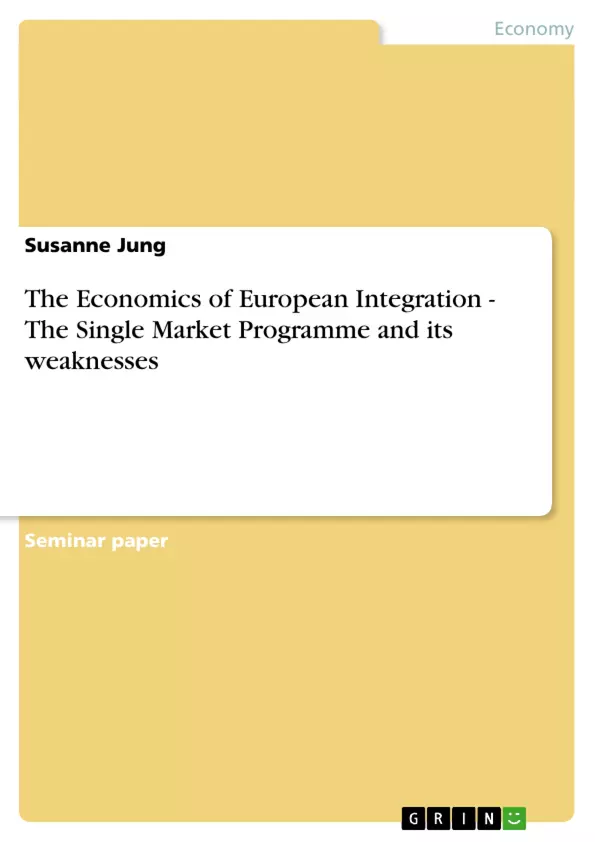Economic integration can be defined as a long-term process in which several stages improve the level of integration. The first step is a free trade area in which internal visible trade restrictions (customs duties, quotas) between partner counties are removed. Examples for those forms of economic integration are the North American Free Trade Area (NAFTA) and the Asian Free Trade Area (AFTA). Adding a common external tariff for non-member countries to the elimination of internal trade obstacles creates ensuing a Customs Union. The next level of integration, the single market for commodities, is achieved by removing visible and invisible trade barriers. Therefore all restrictions on trade between member-countries are abolished and a common external tariff is imposed on external countries. Following to this level free factor mobility of production and of financial assets generate a common market. Next steps to economic integration are the Monetary and lastly the Economic Union by having a common currency and policy. Theme of this essay is critical arguments of disestablish trade barriers towards the European Union (EU) and its underlying economic theories in respective to the Single Market Programme (SMP), its aims and if they are achieved in terms of labour and social policies. Therefore it is necessary to have a focus on the removal of non-tariff barriers (NTBs) exemplary for goods and labour.
Inhaltsverzeichnis (Table of Contents)
- Economic Integration
- Theories of Customs Union
- Trade Creation and Trade Diversion
- Imperfect Competition and Increasing Returns to Scale
- Non-Tariff Barriers (NTBs)
- The Single Market Programme (SMP)
- Aims of the SMP
- Impacts of the SMP
- Types of NTBs
- Physical Barriers
- Technical Barriers
- Fiscal Barriers
- Consequences of NTBs
Zielsetzung und Themenschwerpunkte (Objectives and Key Themes)
This essay critically examines the arguments against trade barriers within the European Union (EU) and its underlying economic theories, particularly in relation to the Single Market Programme (SMP), its goals, and whether those goals are achieved in terms of labor and social policies. The focus is on the removal of non-tariff barriers (NTBs) for goods and labor.
- The impact of trade barriers on economic integration.
- The role of the Single Market Programme (SMP) in removing non-tariff barriers (NTBs).
- The effectiveness of the SMP in achieving its goals in terms of labor and social policies.
- The relationship between trade barriers and the creation and diversion of trade.
- The impact of non-tariff barriers on competition, efficiency, and welfare.
Zusammenfassung der Kapitel (Chapter Summaries)
- Economic Integration: This section introduces the concept of economic integration, outlining its stages from free trade areas to economic unions. The essay focuses on the European Union (EU) and the Single Market Programme (SMP), highlighting its objectives and the critical arguments against trade barriers.
- Theories of Customs Union: This section explores the theoretical foundations of economic integration, focusing on the theory of customs unions. It delves into the welfare effects of specialization and trade, including static and dynamic effects like trade creation and trade diversion.
- Non-Tariff Barriers (NTBs): This section examines the concept of non-tariff barriers (NTBs), which have replaced tariff barriers in many instances. It highlights how the removal of these barriers has a similar impact on trade as the reduction of tariffs, and discusses the Cecchini Report, a research program designed to assess the costs of non-Europe and the potential benefits of the Single Market.
- The Single Market Programme (SMP): This section delves into the Single Market Programme (SMP), which aims to create structural changes within the EU by removing NTBs. It outlines the specific areas covered by the SMP, such as liberalization of trade in goods, cross-border public procurement, and deregulation.
- Types of NTBs: This section categorizes NTBs into three types: physical, technical, and fiscal. It provides examples of each type and explains their impact on trade costs, efficiency, and welfare.
- Consequences of NTBs: This section explores the consequences of NTBs, arguing that they can increase trade costs and hinder the benefits of competition, scale economies, and welfare. It also examines how NTBs can reduce the benefits of trade creation and prevent the emergence of dynamic factors.
Schlüsselwörter (Keywords)
This essay focuses on the economic theories and policies related to European integration, specifically the Single Market Programme (SMP), its objectives, and its effectiveness in removing non-tariff barriers (NTBs). Key concepts explored include trade creation, trade diversion, economies of scale, competition, welfare, and the impact of NTBs on labor and social policies.
- Citation du texte
- Susanne Jung (Auteur), 2002, The Economics of European Integration - The Single Market Programme and its weaknesses, Munich, GRIN Verlag, https://www.grin.com/document/9591



